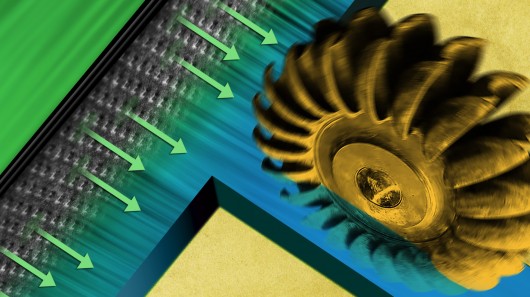
A new study conducted at MIT has examined the potential of pressure-retarded osmosis (PRO), a technique that generates electricity from the difference in salinity between two pools of water separated by a membrane. According to the researchers, tweaking the size of the membrane could help generate electricity much more cheaply than ever before.
PRO was first developed in the early 70s as a way to turn osmotic pressure into electrical power. It involves using a very large semipermeable membrane to allow a solvent, such as fresh river water, to flow into a more concentrated and pressurized solution, such as sea water. Salt molecules pull the fresh water through the one-way membrane and cause an increase in pressure, which is harvested by a turbine to generate power.
The huge amount of fresh river water running into seas and oceans throughout the world makes PRO a very promising prospect. Norwegian electricity company Statkraft, who built the first PRO prototype power plant, estimates that as much as 1,600 TWh per year could be generated in this way. In addition, the same technique could also be used to recover energy from brine, the mildly salty water which is a byproduct of water desalination plants, with an even higher energy output.
So far, the high cost of the semipermeable membrane has made PRO economically unfeasible. MIT graduate student Leonardo Banchik and colleagues have set out to tackle the problem, modeling the performance of large PRO power plants as a function of the size of the membrane. Interestingly, they have found that although a larger membrane will always generate more energy, 95 percent of the maximum power output can be generated with half or less of the maximum membrane area. Reducing the size of the costly membrane would go a long way toward making this renewable energy source more competitive.
Previous studies have also proposed ways of increasing efficiency and reducing costs, but Banchick says that the way in which performance gains were estimated may have been flawed. Researchers usually base their calculations on laboratory-sized membranes that assume a constant flow of water throughout its surface, meaning that the power generated is directly proportional to the size of the membrane. However, says Banchick, on a large-scale membrane this is too crude an approximation, since the salinity and flux of the stream is subject to local variations. The model he and his team developed accounts for this variability.
Since the power output depends on the difference in salinity between the two pools of water, different applications could lead to higher energy outputs. For instance, the researchers found that a mixture of brine and treated wastewater could roughly double the amount of power generated. According to other reports, generating power in the proximity of the Dead Sea or salt lakes could lead to significantly higher returns once the technology comes of age.
One interesting application could be to build a PRO plant that would power a coastal wastewater treatment plant by combining seawater and treated wastewater. The technology is within our reach, even though powering a large treatment plant would admittedly require a membrane of huge proportions, extending for millions of square meters.
"Even though this seems like a lot, clever people are figuring out how to pack a lot of membrane into a small volume," Banchik says. "For example, some configurations are spiral-wound, with flat sheets rolled up like paper towels around a central tube. It’s still an active area of research to figure out what the modules would look like."

 Previous page
Previous page Back to top
Back to top







